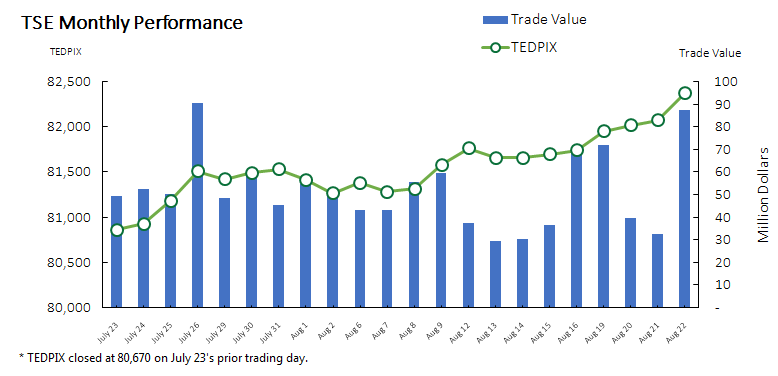Tehran Stock Exchange’s main index TEDPIX gained 1,702 points or 2.1% during the fifth month of the current fiscal year, Mordad (July 23-August 22), to end at 82,372.4.
The index reached its 42-month high in the second trading week of the month. Extending that record any more than a few days requires TEDPIX to cross the 84,000 level and the market’s current momentum has so far prevented a growth in such a scale.
This is while the over-the-counter Iran Fara Bourse’s main index ended the month at its all-time high with two robust heaves on the last two days of the month. IFX gained 13 points or 1.4% during the month to close at 937, zooming past its previous record of 936.86 on May 2.
Mordad was essentially an improved continuation of the month before (Tir) in which both markets successfully regained parts of heavy losses since the year started. Investors now appear more confident in the markets’ capacity for growth and are already looking forward to the new month.
Growing global metal prices, such as copper, aluminum, iron ore and steel, were the main factor driving the Iranian stock market exchanges for the past two months. The growth is expected to continue, as price hikes have not shown any sign of relenting so far.
TEDPIX witnessed its highest growth on July 25, as it jumped 327.6 points. IFX also had its highest rise on July 30 by gathering 8.83 points in a day.
Over 18.08 billion shares valued at $1.2 billion were traded at TSE over the past month, with the number of traded shares and monthly trade value growing by 14.7% and 15.7% respectively compared with the previous month.
TSE's First Market Index gained 1,640 points or 2.9% during the month to stand at 57,745.6. The Second Market Index added 1,268 points or 0.7% to reach 179,391.9
At IFB, more than 4.45 billion securities valued at $948.04 million were traded, indicating a 54% downturn in the number of shares traded and 28% growth in trade value.
More than 600 million securities worth $26.31 million were traded in IFB's First Market, registering a 51% and 58% downturn in the number of traded shares and trade value respectively. Over 2.08 billion securities valued at $38.25 million changed hands in the Second Market, registering a 6% drop and 92% growth in traded shares and trade value respectively.


> CBI’s New Directive on Interest Rates
The Central Bank of Iran announced a new directive to cut interest rates, which is expected to augment the market’s positive signals and boost stocks’ performance for the sixth month of the year, Shahrivar (August 23-September 22).
According to CBI’s economic deputy, Peyman Qorbani, all banks and credit institutions are mandated to set their annual and fixed interest rates at 15% and 10% respectively by Saturday. All deposits made after this motion goes into effect will be affected and non-compliance will lead to penalization.
The rates were already cut in June, as the Money and Credit Council approved the cuts and CEOs of private and state-owned banks agreed to lower long-term deposit rates from 18% to 15% with short-term rates set at approximately 10%. However, many lenders failed to comply, with rates reaching 22% plus when hidden fees were accounted for. The new directive seems to mean that the CBI is serious about cracking down on the issue.
Interest rates are already higher than the inflation rate, which was around 10.3% for the Iranian month ending July 22. Coupled with the sluggishness of the economy, this has caused liquidity to shy away from the high-risk production sector and flow into the safe and high-return money market with high deposit rates.
The new CBI directive, if properly implemented, is expected to help liquidity find its way back to the capital market.
Qorbani noted that the government is monitoring the situation in the bond market and will “address” the issues.
Investors and analysts have repeatedly raised concerns about the deepening gap between the equity and debt markets, and the further flow of capital toward low-risk, high-return bonds. The yield on one-year bonds stands at about 27-29%, which is significantly higher compared to any other investment option.


